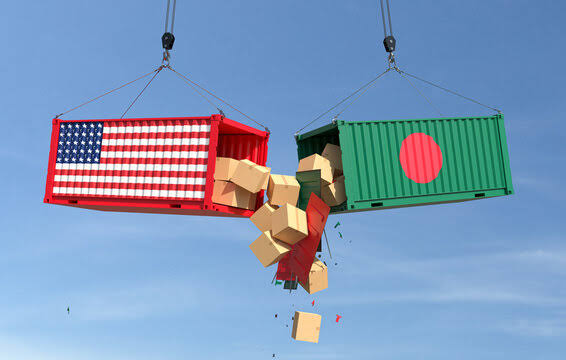Diplomatic Correspondent
Published:2025-08-02 13:29:11 BdST
BD secures big tariff cut from US
In a significant diplomatic triumph, Bangladesh has secured a reduced tariff rate of 20% from the United States, down from a previously announced 35%.
This move, confirmed by the White House on Friday, is a major relief for Bangladesh's export-oriented economy, particularly its vital garment sector.
The new tariff structure follows the third and final round of negotiations held in Washington, D.C. between Bangladeshi officials and the Office of the United States Trade Representative (USTR), which concluded on Thursday night.
As part of these strategic talks, Bangladesh committed to a series of economic concessions, including the purchase of 25 aircraft from Boeing and annual imports of wheat and other goods from the US. These concessions were aimed at narrowing the trade deficit between the two nations.
According to a notice from the White House, the revised tariff will be applicable to goods that "entered for consumption, or [were] withdrawn from warehouse for consumption seven days after the date of the executive order, excluding the day the executive order is signed."
In his immediate reaction shared by the Bangladesh Embassy in Washington, Commerce Adviser Sk. Bashir Uddin said, “With the 20% tariff imposed on Bangladesh, we will remain in a competitive position. There is no possibility that our exports to the United States will be hampered. However, we had expected a rate below 20%.”
Chief Adviser Prof Muhammad Yunus has congratulated the Bangladesh tariff negotiators on securing a landmark trade deal with the United States, terming it a decisive diplomatic victory.
“By reducing the tariff to 20%, 17 points lower than anticipated, our negotiators have demonstrated remarkable strategic skill and unwavering commitment to safeguarding and advancing Bangladesh’s economic interests,” he said in a statement on Friday.
In a separate announcement, the White House confirmed that President Donald Trump will retain a minimum global tariff of 10%, while imports from countries with trade surpluses with the US will face duties of 15% or higher.
Despite initial concerns, garment manufacturers, exporters and economists have expressed cautious optimism about the revised tariff deal.
Speaking to the Daily Sun, Mahmud Hasan Khan Babu, president of the Bangladesh Garment Manufacturers and Exporters Association (BGMEA), said, “After the 37% tariff announced in April, we were on the verge of collapse. The revised rate offers some relief as it will allow us to continue operations. We see this as a positive development.”
Mahmud Hasan, also Managing Director of Rising Group, explained that exporters will now face a total of 35% in duties and tariffs on readymade garments-comprising 15% in duties and 20% in tariffs. He, however, warned that the higher tariff could impact buyers’ purchasing power.
Bangladesh exports about $8 billion worth of garments to the US annually, out of a total export volume of nearly $40 billion. “We will be able to gauge the real impact once the first few shipments are made under the new structure,” he added.
Zahid Hussain, former lead economist at the World Bank’s Dhaka office, said, “The tariff cut to 20% is a welcome relief, but challenges remain. Bangladesh now holds a competitive edge over India and Pakistan and stands close to Vietnam-though without Vietnam’s benefit of Chinese transshipment. To fully capitalise, we must address supply chain inefficiencies and ensure fast, reliable delivery.”
“Sustainable gains will depend on improving labour rights, governance and the overall business climate- areas repeatedly flagged by the US,” he added.
President Trump’s 8 July directive had initially imposed a blanket 35% tariff on all Bangladeshi exports to the US, triggering concerns over its impact on the country’s export-oriented economy, particularly the RMG sector.
To address the longstanding trade imbalance, Bangladesh submitted a formal proposal to the USTR, outlining a roadmap to narrow the gap.
As part of its strategic concessions, Dhaka committed to purchasing 25 aircraft from US aviation giant Boeing, importing seven lakh tonnes of wheat annually for five years, and procuring liquefied natural gas (LNG), cotton, medicines, capital machinery, chemical raw materials, and agricultural goods from the US.
The successful negotiation for Bangladesh presents a stark contrast to the administration’s treatment of other key trading partners, notably India.
Washington has threatened New Delhi with tariffs of 25%, a figure that will single it out more severely than most major economies, except Canada, which was hit with a 35% tariff rate.
According to USTR data, bilateral trade between the two nations reached $10.6 billion in 2024, with Bangladesh exporting $8.4 billion worth of goods to the US- an increase of 1.1% year-on-year.
In contrast, US exports to Bangladesh dipped slightly to $2.2 billion, pushing the US trade deficit with Bangladesh to $6.2 billion.
In April 2025, the US initially slapped a 37% duty on Bangladeshi products, later revised to an additional 10% after a temporary 90-day postponement.
The final agreement to bring the tariff down to 20% signals a diplomatic win for Bangladesh and is expected to stabilise trade flows between the two countries.
The Boeing deal, signed on 27 July, is widely viewed as a strategic countermeasure by Bangladesh- not only to help bridge the trade gap but also to deepen economic and geopolitical ties with Washington.
Unauthorized use or reproduction of The Finance Today content for commercial purposes is strictly prohibited.


